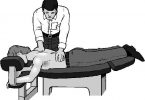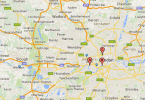The Approach
By Marc Gafni
To understand the mystery of the Temple and what it has to teach us, we need to approach her more carefully. Indeed, the gradual approach towards the center is always the essential formula in the quest of the spirit. The Temple itself was built somewhat like an exquisite mandala. The mandala invites the gazer to pass through layer after layer of imagery before beholding its wondrous core. Similarly, we find that the Temple was a layered structure. The High Priest would ascend the great staircase to the outer Courtyard of Song, pass through the courtyard, into the chamber called the Holy, and from there into the inner most sanctum – the Holy of Holies. In this sanctum sanctorum of the Temple, behind fine brocaded curtains, stood the golden ark of the covenant. The ark contained within it the two tablets of stone upon which were carved the Ten Commandments.[i] Magical lapidary tablets, sculpted by the God-gripped hand of Moses himself.
Most essential though is that which rests atop the ark. Sitting perched aloft the ark are our two winged figures – the celebrated cherubs.[ii] Indeed, their cherubic faces have graced everything from the greatest works of art to countless covers of Hallmark cards. Yet here, according to the esoteric tradition, these images were not of the Hallmark variety. As we mentioned at the outset, these two cherubs were male and female[iii], face to face, meurim zeh b’zeh– intertwined in sexual embrace.[iv] In the language of the Biblical source text the cherubs were, “As one embraced with his lover.” These carved creatures are the focal point, the epicenter of the mandala-like Temple space. [v] /[vi] They sit, like the guarded pupil of the eye, at the source of the sacred.
That such provocatively sexual figurines would have such prominence in the Holy of Holies is mystery indeed. It is called by the Kabbalistic initiates the sod hakeruvim[vii]- the Secret of the cherubs. And though full initiation into this secret cannot be wholly transmitted in the pages of a book, together we can at least hint to its wonder and strive to scrutinize the inscrutable.
Kadoori who is well over a hundered years old via his student and my friend Ras Daveed.
[i] “Tablets and broken tablets were in the Ark”..O source…. To
[ii] . The word Cherub is sister to the Hebrew word Merkava, meaning chariot. The account of the chariot is the core of the Hebrew mystical tradition.
often we throw out the broken tablets of our lives not understanding that they pay a vital part in the sacred fabric of our lives. See Soul Prints….
[iii] Cite source …..cited in Idel KNP
[iii] enter here core text O p
7 – The text describing the cherubs as the sexually intertwined is found in the book of Kings 1 ch 7. There the words are Kemear Ish Ulyoto- one entwined in another. The Talmud understands the Hebrew words Kemear to refer to sexual entwining and describes the cherubs as Meurim zeh be zeh. Yuman p 21 O fn 56 and 57 proving that the
word Meurim derives from the word Er – two letter root which means Arousal ..Ervah…cite also talmudic passage in Yuma 54B where the entire flow of the passage is filled with underlying sexual motifs even when discussing technical details of the tabernacles structure which could easily have far more easily explained without resort to sexual metaphor.. , Eisen , Idel New Perspectives …Sexual Metaphors….,Patai Hebrew Goddesses ch on Cherubim pp …, Man and Temple…pp
[v] cite source …..see O Patai
[v] cite source Kings One chapte
r seven …. see O Pattai
[vi] cit
Marc Gafni on YouTube




